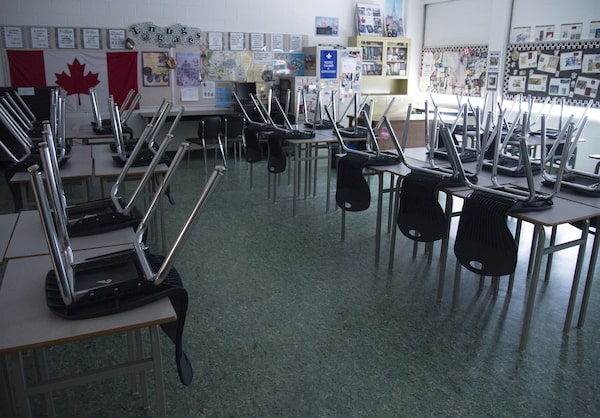
A empty classroom is pictured at Eric Hamber Secondary school in Vancouver on March 23, 2020.JONATHAN HAYWARD/The Canadian Press
Our Morning Update newsletter is written by Globe editors, giving you a concise summary of the day’s most important headlines. Sign up today.
Canada has issued national guidelines on reopening schools, recommending staggered schedules, increased ventilation and masks for children 10 and up.
The Public Health Agency of Canada developed the guidelines, released this weekend, in collaboration with public-health experts. They are not prescriptive, but are intended to support school administrators as they work to develop plans in conjunction with their local health authorities, ministries of education and Indigenous community-governance structures.
“The guidance recommends a layered approach, including decreasing the number of interactions with others and increasing the safety of interactions,” Theresa Tam, Canada’s Chief Public Health Officer, said in a statement.
When do schools reopen? A province-by-province guide
The guidelines recommend non-medical masks for children aged 10 – around Grade 4 – and older based on current evidence of COVID-19 transmission. Ontario has already announced that students in Grade 4 and up will be required to wear masks, including in class, while younger students will be encouraged but not mandated to do the same.
Alberta is requiring masks for students in Grade 4 and up in common areas, but not in class if students are working at their desks. Nova Scotia is requiring them for high-school students in common areas, but not in class. British Columbia says masks will be optional for all and recommended in certain scenarios, such as when students take public transit. (B.C. recently mandated face coverings on public transit.)
“Consideration should be given to encourage teachers and staff to wear face masks and eye protection, such as face shields,” the guidelines read.
Toronto District School Board trustee Michelle Aarts, who is moving a motion to require masks for all students, staff and visitors, said the federal document provided a thoughtful “living” set of guidelines with flexibility to meet local recommendations and adapt protocols as evidence evolves.
Ms. Aarts introduced her motion in part because of emerging research that children may be bigger drivers in the spread of COVID-19 than previously thought, believing the district should “start from the point of most caution.”
“It’s not set in stone, and it’s not forever,” she said Sunday. “We can educate and adjust as needed, as things unfold.”
The motion goes to the board for vote on Aug. 18.
The national recommendations also include modifying practices to reduce how long people are in contact with each other. This could include reducing the number of students who use the same space at one time, grouping students into cohorts, and staggering schedules and breaks.
Ontario plans to maintain normal class sizes for its reopening. However, the province will restrict students to their class group for the entire day. B.C. will also retain full class sizes but has some parents and educators concerned over “learning groups” of up to 60 students in elementary and middle school and up to 120 in high school.
The guidelines recommend physical barriers between students, staff and volunteers, such as placing Plexiglas windows or cubicles higher than head height.
They also recommend increased ventilation, which can be achieved by moving activities – such as lunch, classes or physical activities – outdoors when possible, opening windows when possible and if weather permits, and increasing air exchanges by adjusting the HVAC system.
Patti Bacchus, an education columnist and former chair of the Vancouver School Board, has voiced concern about crowded classrooms with poor ventilation where students will be expected to spend extended periods.
“I’ve been watching jurisdictions all over North America, and what groups are recommending, and that’s everything from HEPA air purifiers to circulate and hopefully filter the air, improve ventilation,” she said. “In lots of classrooms, you can’t even open the windows because they’re painted shut.”
In the event of a confirmed COVID-19 case, schools should have specific policies regarding case and contact management, environmental cleaning and temporary alternative education-delivery models, according to the guidelines. Communication plans should maintain privacy while including audiences such as students, families, school staff and surrounding communities.
 Andrea Woo
Andrea Woo